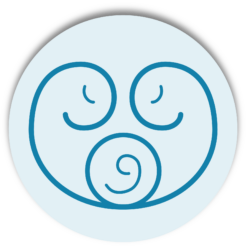Female Fertility Tests & Evaluation
Since the origin of infertility could lie in either or both partners, we evaluate both simultaneously. The following are evaluations involving the female partner.
Follicular-Phase Blood Tests
The best available technique for assessing the quality of a woman’s eggs is measuring what’s known as the ovarian reserve – that is, the number of immature eggs left in a woman’s ovaries. (Females are born with all the eggs they’ll ever have at birth.
Over time, this number depletes at its own rate in each female.) We accomplish this by measuring the hormones FSH (Follicle Stimulating Hormone) and estradiol (E2) on the second, third, or fourth day of the menstrual cycle.
In some cases we perform a clomiphene challenge test in women over the age of 38, or for a woman with a solitary ovary or a prior poor response to fertility medications. This test obtains an estradiol and FSH level on the second, third or fourth day of the menstrual cycle and on day 10 or 11 after taking clomiphene citrate, a medicine that stimulates the production of hormones needed for ovulation, for five days.
The FSH and E2 results determine if the woman needs aggressive therapy and how successful we will be at attaining a pregnancy using her own eggs.
Endometrial Lining
The development of the endometrial lining is dependent on the production of estradiol by the developing ovarian follicle prior to ovulation. The uterine lining (endometrium) thickens in response and also becomes very vascular and juicy in response to progesterone, a hormone produced after ovulation by the corpus luteum for the last two weeks of the menstrual cycle.
This prepares the lining for an embryo, which in the case of successful conception implants seven days after ovulation. In some cases the uterine lining requires evaluation by an endometrial biopsy.
The endometrium and the implantation process are areas undergoing extensive study at this time. It appears that many factors including the development of endometriosis in the pelvis and immune system problems may lead to poor implantation. An active area of research is the study of the deficit of proteins whose function is to anchor the embryo.
The endometrial biopsy test occurs just prior to onset of a menstrual flow.
Endometrial Biopsy
After ovulation, progesterone is produced for the last two weeks of the menstrual cycle to prepare the uterine lining (or endometrium) for the “landing” of the embryo.
To evaluate this lining, an endometrial biopsy is performed just prior to the onset of menstrual flow. If a problem is detected, it usually can be corrected with hormonal therapy.
Egg Quality Assessment
Follicle Stimulating Hormone (FSH) is produced by the pituitary gland to signal the ovaries to grow an egg for the menstrual cycle.
Measuring the levels of FSH and Estradiol (E2) on the second, third, or fourth day of a woman’s cycle is the best available technique to assess the quality of her eggs.
These results will help determine if aggressive therapy is needed and how successful the couple will be at attaining a pregnancy using the woman’s own eggs.
Hysterosalpingogram
The hysterosalpingogram (HSG) test is designed to confirm that both fallopian tubes are open and the uterine cavity is normal. The HSG test, which causes some cramping and discomfort, occurs in the early part of the cycle after completion of menstrual flow but prior to ovulation. This usually takes place between cycle days 6 and 13.
Postcoital Test
For the post-coital test-performed just prior to ovulation-the couple has sexual intercourse 4-10 hours before the office visit.
The physician gently removes a small amount of mucous from the cervix and places it on a slide to evaluate the number and motility of the sperm under a microscope.
This test allows a better understanding of the sperm mucous interaction and may require subsequent use of intrauterine inseminations (IUI) to place the sperm directly into the uterus.

